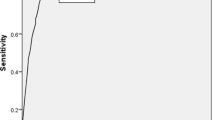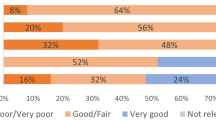Abstract
Study design:
Retrospective Longitudinal Study.
Objectives:
(1) To determine whether the Spinal Cord Injury Activities of Daily Living (SCI_ADL) measure shows adequate item-level and precision psychometrics; (2) to investigate whether the SCI_ADL measure effectively detects ADL changes across time; (3) to describe self-care task(s) participants can and cannot do across time.
Setting:
Two Midwestern hospitals and 1 Southeastern specialty hospital in 1993.
Methods:
All participants were adults with traumatic SCI of at least 1-year duration at enrollment. We used 20-year (1993–2013) retrospective longitudinal data and categorized participants into three injury levels: C1–C4 (cervical; n=50), C5–C8 (n=126) and T1–S5 (thoracic, lumbar and sacral; n=168). We first examined psychometrics of the SCI_ADL with factor and Rasch analyses; then we investigated longitudinal change of SCI_ADL scores at three time points over 20 years (1993, 2003 and 2013) using generalized linear mixed modeling and post hoc analyses.
Results:
The SCI_ADL measure demonstrated unidimensionality, person strata of 2.9, high Cronbach’s α (0.93) and fair person reliability (0.76). T1–S5 had the highest measures, following C5–C8 and C1–C4 at three time points (P<0.05). The C1–C4 and T1–S5 groups showed significant decreases from 2003 to 2013; however, none of the three groups showed significant differences from 1993 to 2003 (P<0.05).
Conclusions:
The SCI_ADL measure could detect longitudinal ADL changes of the population with SCI across time. The C1–C4 group decreased the most in ADLs, indicating higher need of long-term services and rehabilitation.
Similar content being viewed by others
Log in or create a free account to read this content
Gain free access to this article, as well as selected content from this journal and more on nature.com
or
References
Granger CV, Hamilton BB, Keith RA, Zielezny M, Sherwin FS . Advances in functional assessment for medical rehabilitation. Top Geriatr Rehabil 1986; 1: 59–74.
Grey N, Kennedy P . The Functional Independence Measure: a comparative study of clinician and self-ratings. Paraplegia 1993; 31: 457–461.
Heinemann AW, Linacre JM, Wright BD, Hamilton BB, Granger C . Prediction of rehabilitation outcomes with disability measures. Arch Phys Med Rehabil 1994; 75: 133–143.
Fortin CD, Voth J, Jaglal SB, Craven BC . Inpatient rehabilitation outcomes in patients with malignant spinal cord compression compared to other non-traumatic spinal cord injury: a population based study. J Spinal Cord Med 2015; 38: 754–764.
Herzer KR, Chen Y, Heinemann AW, Gonzalez-Fernandez M . Association between time-to-rehabilitation and outcomes following traumatic spinal cord injury. Arch Phys Med Rehabil 2016; 97: 1620–1627.
van Leeuwen CM, Post MW, van Asbeck FW, van der Woude LH, de Groot S, Lindeman E . Social support and life satisfaction in spinal cord injury during and up to one year after inpatient rehabilitation. J Rehab Med 2010; 42: 265–271.
Catz A, Itzkovich M, Steinberg F, Philo O, Ring H, Ronen J et al. The Catz–Itzkovich SCIM: a revised version of the Spinal Cord Independence Measure. Disabil Rehabil 2001; 23: 263–268.
Itzkovich M, Gelernter I, Biering-Sorensen F, Weeks C, Laramee MT, Craven BC et al. The Spinal Cord Independence Measure (SCIM) version III: reliability and validity in a multi-center international study. Disabil Rehabil 2007; 29: 1926–1933.
Ullrich PM, Spungen AM, Atkinson D, Bombardier CH, Chen Y, Erosa NA et al. Activity and participation after spinal cord injury: state-of-the-art report. J Rehabil Res Dev 2012; 49: 155–174.
Jette AM, Tulsky DS, Ni P, Kisala PA, Slavin MD, Dijkers MP et al. Development and initial evaluation of the Spinal Cord Injury-Functional Index. Arch Phys Med Rehabil 2012; 93: 1733–1750.
Krause JS, Newman JC, Clark JM, Dunn M . The natural course of spinal cord injury: changes over 40 years among those with exceptional survival. Spinal Cord 2017; 55: 502–508.
Krause JS, Clark JM, Saunders LL . SCI Longitudinal Aging Study: 40 years of research. Top Spinal Cord Inj Rehabil 2015; 21: 189–200.
LaPlante MP . The classic measure of disability in activities of daily living is biased by age but an expanded IADL/ADL measure is not. J Gerontol B 2010; 65: 720–732.
van den Berg-Emons RJ, Bussmann JB, Haisma JA, Sluis TA, van der Woude LH, Bergen MP et al. A prospective study on physical activity levels after spinal cord injury during inpatient rehabilitation and the year after discharge. Arch Phys Med Rehabil 2008; 89: 2094–2101.
Hetz SP, Latimer AE, Buchholz AC, Martin Ginis KA,, Group S-SR. Increased participation in activities of daily living is associated with lower cholesterol levels in people with spinal cord injury. Arch Phys Med Rehabil 2009; 90: 1755–1759.
Bond TG, Fox CM . Applying the Rasch Model: Fundamental Measurement in the Human Sciences, 2nd edn.Lawrence Erlbaum Associates: Mahwah, NJ, USA. 2007.
Krause JS . Dimensions of subjective well-being after spinal cord injury: an empirical analysis by gender and race/ethnicity. Arch Phys Med Rehabil 1998; 79: 900–909.
Muthen LK, Muthen BO . Mplus User's Guide7th edn.Muthen & Muthen: Los Angeles, CA, USA. 2015.
Linacre JM . A User's Guide to Winsteps Ministeps 3.70.0: Rasch Model Computer Programs. Winsteps: Chicago, IL, USA,. 2012.
Zwick R, Thayer DT, Lewis C . An empirical bayes approach to mantel–haenszel DIF analysis. J Ed Meas 1999; 36: 1–28.
Mallinson T . Rasch analysis of repeated measures. Rasch Meas Trans 2011; 25: 1317.
SAS Institute Inc SAS for Windows, 9.4 edn.SAS Institute: Cary, NC, USA,. 2015.
Revicki DA, Cook KF, Amtmann D, Harnam N, Chen WH, Keefe FJ . Exploratory and confirmatory factor analysis of the PROMIS pain quality item bank. Qual Life Res 2014; 23: 245–255.
Schumacker RE, Lomax RG . A Beginner's Guide to Structural Equation Modeling, 2nd edn.Lawrence Erlbaum Associates: Mahwah, NJ, USA,. 2004.
Reeve BB, Hays RD, Bjorner JB, Cook KF, Crane PK, Teresi JA et al. Psychometric evaluation and calibration of health-related quality of life item banks: plans for the Patient-Reported Outcomes Measurement Information System (PROMIS). Med Care 2007; 45 (Suppl 1): S22–S31.
Linacre JM . Rasch model estimation: further topics. J Appl Meas 2004; 5: 95–110.
Linacre JM . Predicting responses from Rasch measures. J Appl Meas 2010; 11: 1–10.
Smith EV Jr. . Detecting and evaluating the impact of multidimensionality using item fit statistics and principal component analysis of residuals. J Appl Meas 2002; 3: 205–231.
Smith RM, Schumacker RE, Bush JM . Using item mean squares to evaluate fit to the Rasch model. J Outcome Meas 1998; 2: 66–78.
Linacre JM . Optimizing rating scale category effectiveness. J Appl Meas 2002; 3: 85–106.
Wright BD, Masters GN . Number of person or item strata. Rasch Meas Trans 2002; 16: 888.
McHorney CA, Tarlov AR . Individual-patient monitoring in clinical practice: are available health status surveys adequate? Qual Life Res 1995; 4: 293–307.
Cohen J . Statisical Power Analysis for the Behavioral Sciences2nd edn.Erlbaum: Hillsdale, NJ, USA,. 1988.
McHorney CA . Use of item response theory to link 3 modules of functional status items from the Asset and Health Dynamics Among the Oldest Old study. Arch Phys Med Rehabil 2002; 83: 383–394.
Bode RK, Heinemann AW, Kozlowski AJ, Pretz CR . Self-scoring templates for motor and cognitive subscales of the FIM instrument for persons with spinal cord injury. Arch Phys Med Rehabil 2014; 95: 676–9 e5.
Prodinger B, Ballert CS, Brinkhof MW, Tennant A, Post MW . Metric properties of the Spinal Cord Independence Measure-Self Report in a community survey. J Rehabil Med 2016; 48: 149–164.
Krause JS, Carter RE, Pickelsimer E, Wilson D . A prospective study of health and risk of mortality after spinal cord injury. Arch Phys Med Rehabil 2008; 89: 1482–1491.
Acknowledgements
The contents of this publication were developed under a grant from the National Institute on Disability, Independent Living and Rehabilitation Research (NIDILRR; grant number 90IF0015). NIDILRR is a Center within the Administration for Community Living (ACL), Department of Health and Human Services (HHS). The contents of this publication do not necessarily represent the policy of NIDILRR, ACL, HHS, and you should not assume endorsement by the Federal Government.
Author information
Authors and Affiliations
Corresponding author
Ethics declarations
Competing interests
The authors declare no conflict of interest.
Additional information
Supplementary Information accompanies this paper on the Spinal Cord website
Rights and permissions
About this article
Cite this article
Li, CY., Velozo, C., Hong, I. et al. Generating Rasch-based activity of daily living measures from the Spinal Cord Injury Longitudinal Aging Study. Spinal Cord 56, 14–21 (2018). https://doi.org/10.1038/sc.2017.99
Received:
Revised:
Accepted:
Published:
Issue date:
DOI: https://doi.org/10.1038/sc.2017.99



